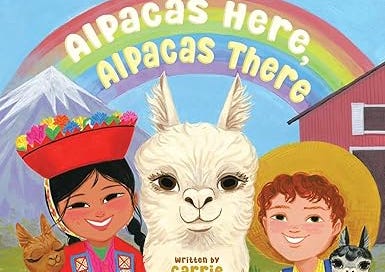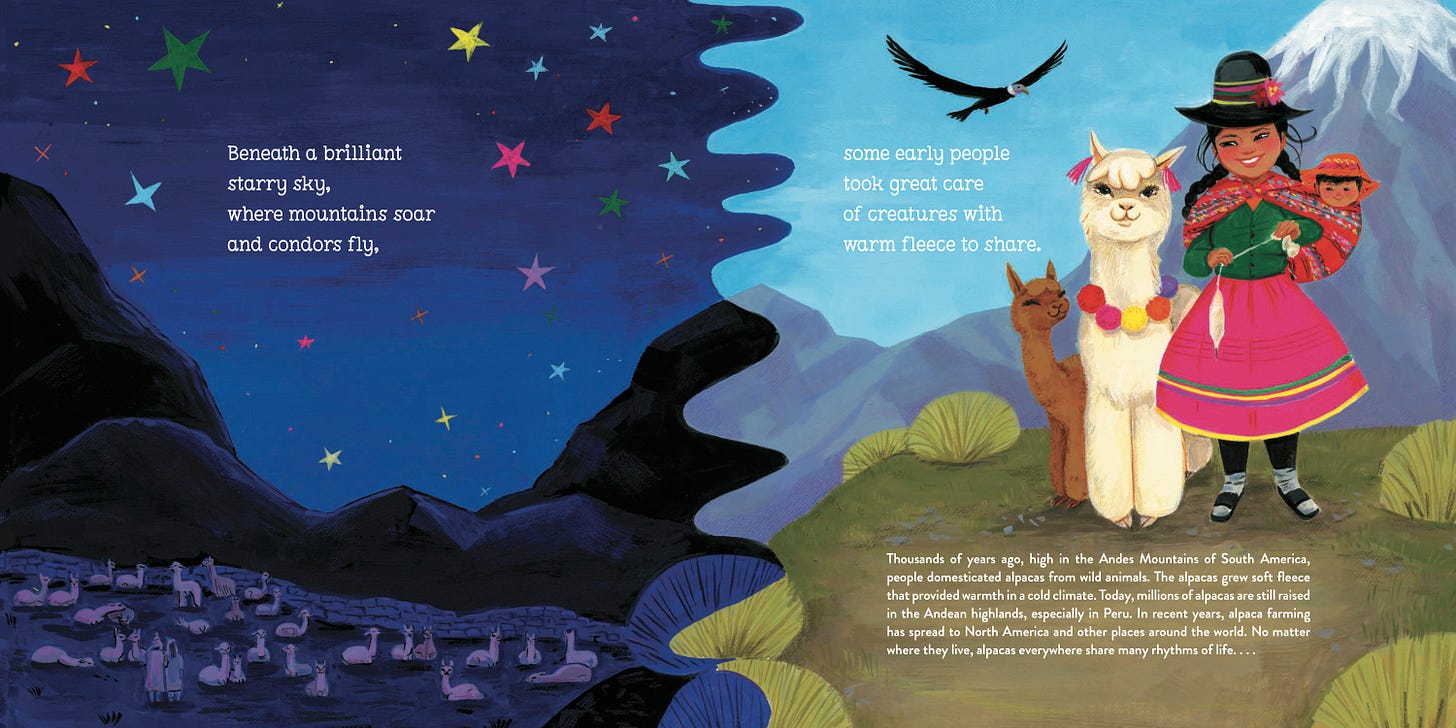Welcome to the March 2025 edition of PB First Lines!
I’m so glad you’re here.
If you’re interested in feedback on a first line, fill out this anonymous form, and I’ll analyze them in the next newsletter.
Have you read and loved a middle grade novel that you would like to suggest for my MG First Page Revision Journey series? Let me know in the comments!
Carrie Tillotson is here today to share the revision journey of the first line of her book, Alpacas Here, Alpacas there, art by Elisa Chavarri.
********
The revision journey of ALPACAS HERE, ALPACAS THERE (Beach Lane Books, 2025), illustrated by Elisa Chavarri, is a long and winding one—from rhyme to prose and back again.
Original First Lines (October 16, 2015, ALPACAS IN THE ANDES):
Under the gently rising sun of a crisp, spring morn,
An alpaca nuzzles with her cria, newly born.
This was one of the first stories I worked on when I decided to write seriously for children, but I (obviously) knew nothing about writing in rhyme. The stanza has no consistent meter, rhythm, or structure, and uses awkward forced rhyme that doesn’t sound natural. I had a critique at an SCBWI conference with an editor, who encouraged me to revise the story in prose. We also discussed how it would be great to compare and contrast alpacas being raised in different places, and she requested that I send it to her after revising.
Revised First Lines (December, 3, 2015, ALPACAS IN THE ANDES, ALPACAS ON THE FARM):
Beneath the gently rising sun of a crisp, spring morn, two crias are born.
[Secondary Text: Baby alpacas, called crias, are usually born in the morning so they can dry out and warm up before the chilly Andean night air settles.]
As I revised the story into prose, I had been reading a number of nonfiction picture books with layered text, and decided I wanted to use that approach, too. I later submitted a version with these same starting lines to the editor, who passed on it.
Revised First Lines (July 17, 2017, ALPACAS IN OREGON, ALPACAS IN PERU):
On a crisp spring morning, baby alpacas nuzzle their mamas.
Yana lives on a farm in Oregon's Willamette Valley.
Yuraq lives on a farm high in the Andes Mountains of Peru.
Over many months (and years!), I kept revising. In this version I was trying to close in on where the alpacas were being raised to a narrower geographic region. But I didn’t like how specific the text had gotten. It felt too niche, and at this point it felt like the whole book wasn’t working at all. But my critique partner, Hannah Holt, had a great title idea…
Revised First Lines (September 18, 2017, ALPACAS HERE, ALPACAS THERE)
Alpacas here, alpacas there,
nuzzle close in cool, spring air.
[Secondary Text: Baby alpacas, called cria, are usually born in the morning, so they can warm up before nightfall.]
Hannah’s suggestion of the new title, ALPACAS HERE, ALPACAS THERE, unlocked something in me. It sounded so lyrical and sparked an invitation to rhyme again. Somehow, this story was telling me it needed to rhyme. I dove headfirst into learning how to write in rhyme properly, with consistent meter and structure, and without forced or slant rhyme.
Revised First Lines (March 10, 2019, ALPACAS HERE, ALPACAS THERE)
Alpacas here,
alpacas there,
relax and rest
in mama’s care.
[Spread 1] Baby alpacas, called cria, are usually born in spring. In North America, that’s in April or May, when days grow long and warm. In the Andes Mountains of South America, that’s December, during the wet and rainy season, when grass grows long and lush.
This is the version that I sent to my agent, Tracy Marchini, as a package of manuscripts in 2020, when she decided to take me on as a client. Notice that the beginnings have stayed consistent from the original version in terms of theme, starting out with baby alpacas being born, regardless of whether the story was in rhyme or prose. I loved the gentle scene this imagery set, and I wanted the story to loosely follow “a year in the life” of a cria.
Revised first lines (November 17, 2022, ALPACAS HERE, ALPACAS THERE)
Alpacas here,
alpacas there,
relax and rest
in mama’s care.
Baby alpacas are called crias. In the Andes Mountains of South America, crias are typically born in January through March, when grass grows long and lush. In North America, they are born May through September, when days grow long and warm.
The story got acquired by none other than the original editor from seven years earlier, Andrea Welch with Beach Lane Books! This version is from my first round of revisions with Andrea. Notice that the secondary text changed in structure a bit by referencing facts from South America first, then North America. This was to synchronize with the history of alpacas and how they were first domesticated in South America, then spread to other parts of the world (thanks to critique partner Lolly Ward for that tip!) I also requested that we work with a sensitivity reader to ensure cultural authenticity for the parts of the manuscript set in South America.
Final first lines (January 23, 2023, ALPACAS HERE, ALPACAS THERE)
Beneath a brilliant
starry sky,
where mountains soar
and condors fly,
some early people
took great care
of creatures with
warm fleece to share.
Thousands of years ago, high in the Andes Mountains of South America, people domesticated alpacas from wild animals. The alpacas grew soft fleece that provided warmth in a cold climate. Today, millions of alpacas are still raised in the Andean highlands, especially in Peru. In recent years, alpaca farming spread to North America and other places around the world. No matter where they live, alpacas everywhere share many rhythms of life…
Feedback from Mariana Llanos, amazing authenticity reader and author herself, suggested weaving in more information about the history, importance, and relevance of alpaca farming in Andean cultures. She noted that much of that information was in the back matter, but didn’t want readers to miss it if they didn’t read those pages. Andrea and I agreed, and decided to include, among other things, a new introductory spread to better set the stage for alpacas and their people. From here, the story flows into the previous first stanza, “Alpacas here, alpacas there…”
Thank you for sticking with me through this long and winding revision journey! The examples shared here are a significant but small sampling of all the different revisions I made over 10 years. I hope my revision journey inspires you to keep working!
*********
Revision tip: If a story insists on being written in rhyme, make sure you know how to do it well. And if your story includes details about a culture not your own, seriously consider getting a sensitivity reader. It’s not a free service, but it’s important.
If you read and enjoy Alpacas Here, Alpacas There, leave a review! If you need help getting started writing a review, read this blog post.
Check out my picture book critique services.
Sara goes above and beyond, delivering a critique that is both exceptional and encouraging. She skillfully suggests where to trim and tighten.
Amy Leskowski








What an amazing transformation - bravo! Love how you incorporated feedback in your revision process.